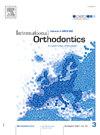不同牙周条件大鼠正畸牙运动过程中自噬和细胞凋亡的表达
IF 1.9
Q2 DENTISTRY, ORAL SURGERY & MEDICINE
引用次数: 0
摘要
目的牙周炎患者的骨重塑和组织损伤难以预测,正畸治疗具有挑战性。因此,本研究旨在通过大鼠正畸牙齿运动(OTM)模型,探讨正畸力对不同炎症状态下牙周韧带细胞自噬、细胞凋亡和骨重塑的影响。材料与方法雄性Sprague - Dawley大鼠75只,分别建立牙周健康组、活动性牙周炎组和稳定性牙周炎组的OTM模型。在12周龄时施加正畸力,在施加正畸力后的第0、1、3、7和14天对大鼠实施安乐死。微计算机断层扫描量化了OTM距离、牙槽骨嵴吸收和骨小梁微结构参数。免疫组织化学和抗酒石酸酸性磷酸酶染色评估牙周韧带炎症、自噬、凋亡、成骨和破骨细胞的表达水平。结果活动性牙周炎组牙外膜距离、牙槽骨吸收、破骨细胞活性最大,炎症因子表达持续高。在该组中,自噬相关蛋白在张力侧升高,而在压缩侧降低,而凋亡蛋白的表达明显升高。骨因子水平较低,在活动性牙周炎组中观察到较早的峰值下降。牙周健康组保持较高的成骨活性,而稳定牙周炎组介于两者之间。结论活动性牙周炎的炎症微环境与正畸力相互作用,破坏保护性自噬-细胞凋亡平衡,导致组织破坏增加。健康、稳定的牙周组织表现出适应性重塑,强调了在正畸治疗前控制炎症的重要性。本动物实验程序符合ARRIVE指南,并经首都医科大学口腔医学院动物伦理与福利委员会批准(No∶KQYY-202207-005)。本文章由计算机程序翻译,如有差异,请以英文原文为准。
Expression of autophagy and apoptosis during orthodontic tooth movement alveolar bone remodeling in rats with varied periodontal conditions
Objective
Orthodontic treatment in periodontitis patients is challenging due to unpredictable bone remodeling and tissue damage. Therefore, this study aimed to investigate the effects of orthodontic force on periodontal ligament cell autophagy, apoptosis, and bone remodeling under various inflammatory states using a rat orthodontic tooth movement (OTM) model.
Material and methods
Seventy-five male Sprague – Dawley rats were used to establish OTM models for the periodontal health, active periodontitis, and stable periodontitis groups. Orthodontic force was applied at twelve weeks of age, with rats euthanized on days 0, 1, 3, 7, and 14 after force application. Microcomputed tomography quantified the OTM distance, alveolar bone crest resorption, and trabecular bone microarchitecture parameters. Immunohistochemistry and tartrate-resistant acid phosphatase staining evaluated the expression levels of inflammation, autophagy, apoptosis, osteogenesis, and osteoclast numbers in the periodontal ligament.
Results
The active periodontitis group exhibited the greatest OTM distance, alveolar bone resorption, and osteoclast activity, along with consistently high inflammatory factor expression. In this group, autophagy-related proteins increased on the tension side but decreased on the compression side, while apoptotic protein expression significantly rose. Osteokine levels were low, with an earlier peak decline observed in the active periodontitis group. The periodontal health group maintained high osteogenic activity, and the stable periodontitis group fell in between the two.
Conclusions
The inflammatory microenvironment in active periodontitis interacts with orthodontic force to disrupt the protective autophagy-apoptosis balance, coinciding with increased tissue destruction. Healthy, stable periodontium shows adaptive remodeling, emphasizing the importance of controlling inflammation before orthodontic treatment. This animal experimental procedure complies with the ARRIVE guidelines, and this research was approved by the Animal Ethics and Welfare Committee of the School of Stomatology, Capital Medical University (No̊ KQYY-202207-005).
求助全文
通过发布文献求助,成功后即可免费获取论文全文。
去求助
来源期刊

International Orthodontics
DENTISTRY, ORAL SURGERY & MEDICINE-
CiteScore
2.50
自引率
13.30%
发文量
71
审稿时长
26 days
期刊介绍:
Une revue de référence dans le domaine de orthodontie et des disciplines frontières Your reference in dentofacial orthopedics International Orthodontics adresse aux orthodontistes, aux dentistes, aux stomatologistes, aux chirurgiens maxillo-faciaux et aux plasticiens de la face, ainsi quà leurs assistant(e)s. International Orthodontics is addressed to orthodontists, dentists, stomatologists, maxillofacial surgeons and facial plastic surgeons, as well as their assistants.
 求助内容:
求助内容: 应助结果提醒方式:
应助结果提醒方式:


